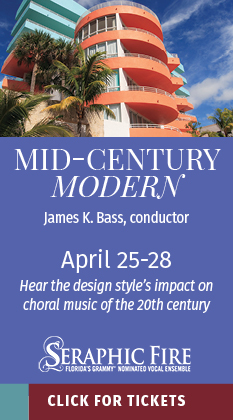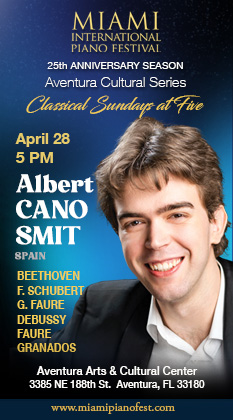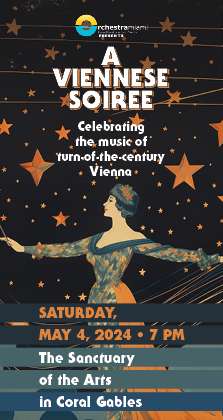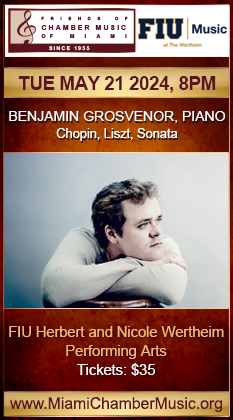New World members display admirable touch in chamber program
![Felix Mendelssohn's String Quintet in B flat was performed by New World Symphony members Sunday afternoon in Miami Beach. [Wilhelm Hensel painting, 1847]](https://southfloridaclassicalreview.com/wp-content/uploads/2017/01/Felix_Mendelssohn_Bartholdy_-_Wilhelm_Hensel_1847.jpg)
Felix Mendelssohn’s String Quintet in B flat was performed by New World Symphony members Sunday afternoon in Miami Beach. [Wilhelm Hensel painting, 1847]
The program consisted of two hallmark compositions of the chamber repertory: Brahms’ Piano Trio in C Major and Mendelssohn’s String Quintet in B-flat Major, both late works in each composer’s creative output. They were coupled with two lesser-known works by Belgian composers, Joseph Jongen and Flor Peeters.
Two Pieces for Flute, Cello, and Harp by Joseph Jongen opened the concert with a poetic atmosphere, reminiscent of Debussy’s Prélude à l’après-midi d’un faune. The first part evoked imagery of a far-away fantasy land with its whole-tone mode, lilting rhythms, and bird-like trills in the flute. Cellist Alan Okhubo and flutist Elisabeth Lu captured the seamless movement of phrases in their unison sections. Harpist Julia Coronelli, although accurate, lacked fluidity in the thematic material, which somewhat affected the overall mood.
However, the harpist’s colorful arpeggios in the second piece supplied a beautiful undertone to the vivid flute passages and the percussive cello theme. A better projected middle register in the rhapsodic interlude of the cello and more focused syncopations in the Vif section would have added a much-needed layer to the performance.
Johannes Brahms waited twenty-six years before composing his second piano trio in 1880. The Trio in C Major is an exemplary work of Brahms’ spare writing where every note is imbued with importance and meaning. In a nod to Beethoven’s middle period, the minimal thematic material is repurposed, elaborated, expanded, and masterfully crafted as it ventures from one instrument to the other.
The Allegro showcased the passionate playing of violinist Rachel Sandman, as well as the maturity and restraint of cellist Thomas Carpenter. Unfortunately, pianist Dean Zhang fell short in taking charge of the score, as his subdued playing kept the crucial keyboard part in the background. Especially lacking was the Brahmsian depth of sonority in the lower register and full-bodied chordal sections.
Nonetheless, he managed to recover from this imbalance in the solo interludes of the Andante con moto with assertive, yet heartwarming voicing. The Scherzo was fully in Zhang’s wheelhouse as he breezed through the crisp and light passages. Sandman and Carpenter highlighted the dark-devilish character of C minor with outstanding bow control and tightness of tremolos. Though at times bordering on aggressiveness of sound, especially leading up to resolutions, the Finale showcased Sandman’s dominant musical presence.
A mélange of Renaissance vernaculars, Flor Peeters’ Suite for Four Trombones (1955) led off the second half delightfully. The brass fellows had arranged the composition for three trombones and tuba. Bass trombonist Christopher Hernacki pointed out that the suite is a virtual dictionary for orchestral trombone playing. The regal “Entrata” filled the space with rich vibrations. The choral-like “Lied” reached out with expressive singing tone, much like in a Brahms symphony, though the “Flemish Dans” lacked somewhat in rhythmic precision and alignment of attacks. The final movement showcased exciting overlay of canonic entrances and climaxes that resounded like a full orchestra.
Although a late work, Mendelssohn’s String Quintet in B flat closed the program with youthful urgency. Violinists Gregory Cardi and Peiming Lin, violists Kurt Tseng and Jarrett Threadgill, and cellist Ian Greenberg were by far the most successful ensemble of the afternoon. Apart from some inconsistent tuning moments in the outer movements, their performance stood out as the most unified musically and technically.
It is challenging to strike a balance between the Classical elegance and Romantic pathos of Mendelssohn’s language, yet the quintet managed to do so by effortlessly transitioning through the hocketting lines of the second and fourth movements, which propelled the music forward. The Adagio e lento exhibited the ensemble’s care of each phrase. Breathing like one, they drew the audience in and created an atmosphere of intimacy as they allowed for the gradual intensity of the music to grow.
The quintet’s dynamic palette ranged from whispering pianissimo to orchestral fortissimo, particularly in the fugal and climactic sections of the Allegro molto vivace. The conversational beauty of chamber music was apparent as the quintet wrapped up the program by receiving a deserved standing ovation.
Posted in Performances
Leave a Comment
Mon Jan 30, 2017
at 12:32 pm
No Comments






